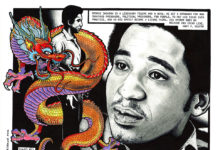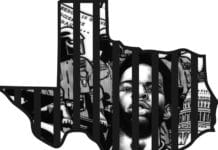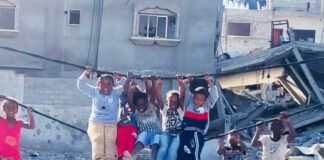by Kijana Tashiri Askari
On Jan. 29, 2015, my travels began with a wakeup call at 2:30 a.m. I was told by the first watch unit officer to be ready in 30 minutes. Myself and a total of 17 prisoners were all rounded up like chattel slaves and placed in the SHU’s C-Facility visiting room holding cells ‘til we boarded the bus at 6 a.m.

In hitting the highway, my sensibilities immediately went through the whirlwind cycle of “shock and awe” via the vivid reminder of what freedom used to entail. I mean, think about it: We’re talking about 20 years of being entombed in Pelikkkan Bay’s torture chambers, without any environmental stimulation or human contact!
So just imagine how my senses voraciously feasted upon the sight of cows and horses parlaying in the open fields, the sight of the ocean’s waters roaring and brushing up against the elements of Motha Earth, the sight of enormous mountains and trees, along with green grass and birds flying in the clear blue sky – as free as they wanna be! The sight of social activity, seeing other human beings exercising, walking, driving their cars and doing everything they wanted to do – simply because they were free!
To my surprise, it got better. We had a one-hour layover at San Quentin, and times definitely have changed since I was last there in the late ‘80s and early ‘90s. San Quentin’s lower yard now has tennis courts?! And they’ve completely remodeled the Receiving and Release (R&R) Building.
As we left San Quentin, I was reminded of the old saying that “some gifts just keep on giving.” I was able to take in the sights of the historic landmarks of the new Bay Bridge extensions, the BART train and parts of my hometown, in West Oakland, California, via the West MacArthur maze freeway.
While not a religious person, I thought I had died and gone to heaven – because as a person serving a life sentence, I never would’ve believed that the good fortune of seeing home would come to fruition in my lifetime … ever again.
In hitting the highway, my sensibilities immediately went through the whirlwind cycle of “shock and awe” via the vivid reminder of what freedom used to entail. I mean, think about it: We’re talking about 20 years of being entombed in Pelikkkan Bay’s torture chambers, without any environmental stimulation or human contact!
The safari from Pelikkkan Bay continued. While awaiting transfer to Corcoran SHU on Step 4 of the Step Down Program (SDP), we were held in the Ad-Seg Unit at DVI-Tracy State Prison – the “slave kamp” – via the now standard week long layover.
The only good things about DVI-Tracy were: 1) The food is prepared with seasoning and tastes a whole lot better, and they still issue real jelly and syrup, unlike Pelikkkan Bay; 2) You finally see prison guards of color – Afrikans and Mexicans – who treat you fairly decent; and 3) They’ve upgraded the R&R holding cell area with top of the line flat screen TVs where they showed us quality “grown folk” movies that just came out. That is a complete 360 from the kindergarten flicks shown at Pelikkkan Bay.
However, the living conditions in the Ad-Seg Unit (L-Wing) cells is outright deplorable – filthy and disgusting. The sinks are broken with holes in them, and the drinking water is brown! It’s like drinking water from a water hole in an underdeveloped country.

And you know that the water has been compromised, when the prison guards are walking around with bottles of drinking water for themselves and when your soap doesn’t even lather up during showers. Every environmental water agency needs to be notified about this so that it can be investigated and corrected ASAP. There is no telling what level of contaminants these prisoners are being forced to drink.
On Feb. 3, 2015, we were back on the road, and for the first time in 20 years, I had the pleasure of seeing the sunrise! The script couldn’t have played out any better, until the rude awakening of my arrival to the Corcoran slave plantation, my new internment kamp for the next foreseeable years, via indefinite SHU status.
For the first time in 20 years, I had the pleasure of seeing the sunrise!
Unfortunately, we had a New Afrikan of the Damu tribe lose his discipline, as he fell for the fascist antics of the Corcoran welcoming committee who greet you upon exiting the bus, where they intentionally roughhouse you to try to provoke a “reaction.”
As I approached the stairs to exit the bus, I was immediately identified by Sgt. A.R. Perez, who told me I would be going to 4B1L, the validated prison gang housing unit. But for reasons unknown, I’m currently housed in 4A4L, a unit for informants and debriefers, which is a typical Cointelpro tactic, aimed at neutralizing and isolating all committed revolutionaries. Upon my relentless protest, I have since been rehoused.
Our struggle continues!
Send our brother some love and light: Kijana Tashiri Askari, s/n Marcus Harrison, H-54077, Cor SHU 4B1L-31, Step-4, P.O. Box 3476, Corcoran, CA 93212.

 Store
Store






